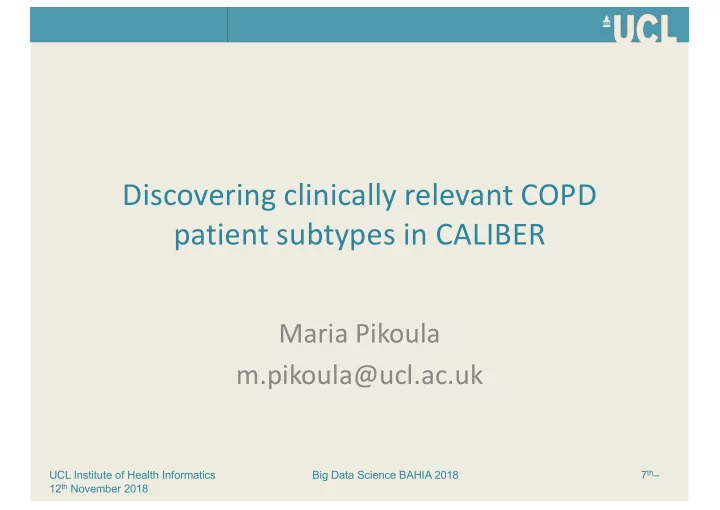

Discovering clinically relevant COPD patient subtypes in CALIBER Maria Pikoula m.pikoula@ucl.ac.uk 7 th – UCL Institute of Health Informatics Big Data Science BAHIA 2018 12 th November 2018
Chronic obstructive pulmonary disease (COPD) COPD is a lung disease characterized by chronic obstruction of lung airflow that interferes with normal breathing and is not fully reversible . – Bronchitis: airways are inflamed and narrowed. – Emphysema affects the air sacs at the end of the airways in the lungs.
COPD burden • Not simply a "smoker's cough" but an under- diagnosed, life-threatening lung disease. • Prevalence: 251 million cases globally in 2016.* • More than 90% of COPD deaths occur in low and middle-income countries. *Global Burden of Disease Study 2016
Severity GOLD grade (spirometry) Severity FEV1 % predicted FEV 1 (Liters): Mild (GOLD 1) >= 80 Moderate (GOLD 2) 50 - 79 Volume that has been Severe (GOLD 3) 30 - 49 exhaled at the end of the first second of Very severe (GOLD 4) < 30 forced expiration MRC shortness of breath scale Grade Activity affected FEV 1 % predicted: 1 Only strenuous activity FEV 1 of the patient divided by the 2 Vigorous walking average FEV 1 in the population 3 With normal walking for any person of similar age, sex and body composition. 4 After a few minutes of walking 5 With changing clothing
Acute Exacerbations of COPD • Acute exacerbations are a major driver of the disease • The factors that govern AECOPD and disease progression are not well-understood
Study aims I. Use electronic health records data to discover new subtypes of COPD with in a hypothesis – free analysis. II. Evaluate subtypes with regards to clinically relevant outcomes such as AECOPD
Cluster analysis in COPD Literature review 1985 - 2017 Vasquez Guillamet (2016) Bergel et al. (2017) Rennard et al. (2015) *Disantostefano et al. (2013) *Spinaci et al. (1985) *Burgel et al. (2012) *Garcia-Aymerich et al. (2011) *Burger et al. (2010) *Cho et al. (2010) *Burgel et al. (2012) *Vanfleteren et al. (2013) 0 500 1000 1500 2000 2500 3000 3500 N participants * Pinto et al. Respiratory Research 2015
Cluster analysis in COPD Literature review 1985 - 2017 This study Vasquez Guillamet (2016) Bergel et al. (2017) Rennard et al. (2015) *Disantostefano et al. (2013) *Spinaci et al. (1985) *Burgel et al. (2012) *Garcia-Aymerich et al. (2011) *Burger et al. (2010) *Cho et al. (2010) *Burgel et al. (2012) *Vanfleteren et al. (2013) 0 5000 10000 15000 20000 25000 30000 35000 N participants * Pinto et al. Respiratory Research 2015
CALIBER data resource AECOPD Stable AECOPD GP registration COPD dx angina dx primary care hospitalization Death Spirometry, Diagnosis, Blood Cough, smoking blood tests, Death as a pressure, sputum, CPRD review, prescriptions result of smoking, hospital prescriptions (aspirin, AECOPD alcohol use… referral (LABA, ICS) nitrates) admit/discharge admit/discharge dates, primary dates, primary HES diagnosis: viral diagnosis: pneumonia AECOPD Date of death, ONS causes: AECOPD COPD Denaxas et al. IJE 2012
Methods • COPD phenotype using validated Read codes and smoking status • 15 risk factors : Sex, BMI, GOLD grade, smoking status, anxiety, depression, atopy, chronic rhinosinusitis, hypertension, heart failure, ischemic heart disease, diabetes, gastroesophageal reflux disease, therapy regimen • K-means clustering algorithm on complete cases, find optimal solution • Label clusters based on defining characteristics
Results Cluster 1 n = 2,066 9 % Cluster 2 Overall cohort complete cases: n = 8,040 30,961 34% Cluster 3 Test set: 7,686 Training set: 23,275 n = 4,362 19% Cluster 4 n = 6,757 29% Cluster 5 n = 2,050 9%
Results – Cluster characteristics Overall 1: Anxiety/ 2: Not 3: CVD / 4: Severe 5: Obesity / cohort Depression comorbid Diabetes COPD / frail Atopy N 30,961 2,066 8,040 4,362 6,757 2,050 Male patients % 55 18 68 81 37 43 BMI % Underweight 4 9 0 0 10 0 BMI % Obese 30 18 32 54 11 53 Depression % 11 66 0 2 3 22 Atopy % 12 15 11 14 9 22 Heart failure % 15 5 10 46 2 24 GOLD % 1 (least severe) 26 35 24 22 27 29 % 4 (most severe) 3 3 2 2 6 1 High Eosinophils % 66 50 73 76 54 66
Clinical Evaluation: AECOPD Primary care exacerbations Hospitalizations
Clinical Evaluation: Respiratory /CVD mortality Age-adjusted Cox regression Characteristic Hazard ratio Age 1.08 [1.07 – 1.08] Cluster Not comorbid 1 Anxiety / Depression 1.28 [1.13 – 1.46] CVD / Diabetes 1.49 [1.38 – 1.60] Severe COPD / Frailty 1.30 [1.20 – 1.40] Atopy / Obesity 1.15 [ 1.03 – 1.30]
Conclusions & Impact • COPD patient subtypes can be identified using routinely generated EHR from primary care. • Previous findings on CVD and diabetes diabetes were reproduced, and the trend is similar for exacerbations • Anxiety and depression are distinct comorbidities potentially driving disease progression in younger, female patients • Atopic and potentially asthmatic patients form a distinct cluster with overall better prognosis
Future directions • Longitudinal evolution of COPD subtypes • Models that allow patient membership of more than one subtype • Genetic associations (UK Biobank) • The role of comorbid respiratory conditions: Asthma and bronchiectasis
Natalie Spiros Fitzpatrick Denaxas Alicia Maxine Nonie Uijl Mackintosh Alexander Arturo Kenan Gonzalez-Izquierdo Direk Ghazaleh Vaclav Fatemifar Papez Michalis Colin Katsoulis Josephson http://denaxaslab.org/ Jennifer K Quint Marcos Barreto
Recommend
More recommend